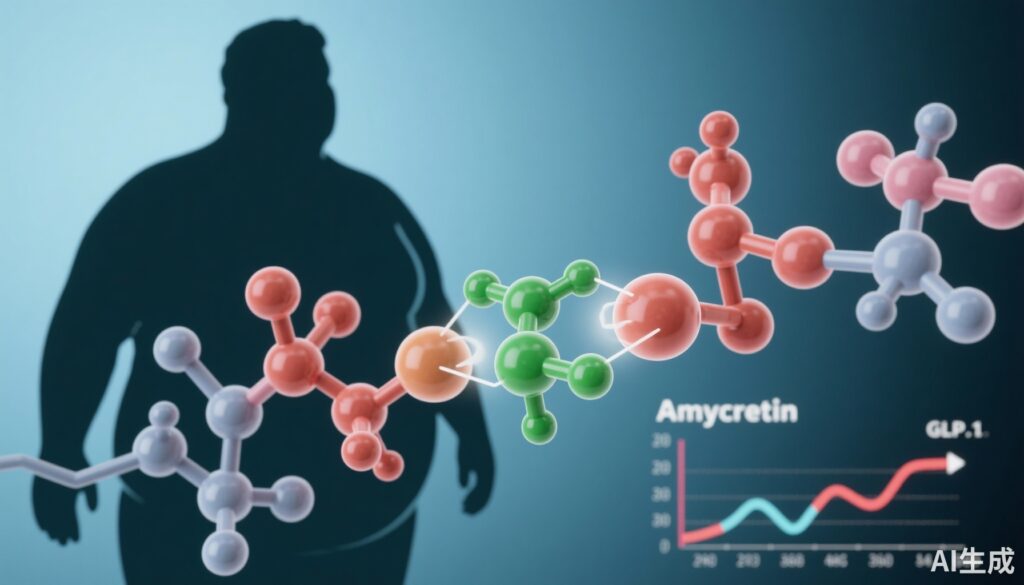Highlight
– Amycretin is the first single-molecule dual agonist targeting both GLP-1 and amylin receptors, designed for overweight and obesity treatment.
– In a phase 1, randomized, double-blind, placebo-controlled trial involving 144 participants, amycretin showed favorable safety and tolerability profiles across escalating doses.
– Pharmacokinetic analyses revealed dose-proportional plasma concentrations supporting predictable dosing.
– Exploratory pharmacodynamics showed promising trends in body weight reduction and fasting glucose improvements warranting further clinical development.
Study Background and Disease Burden
Obesity and overweight conditions constitute a major global health burden, predisposing individuals to type 2 diabetes, cardiovascular disease, and other comorbidities. Despite various pharmacotherapies, a significant unmet need remains for effective, safe, and well-tolerated treatments that offer sustained weight reduction and improved metabolic control. GLP-1 receptor agonists and amylin receptor agonists have independently demonstrated clinically significant weight loss and glucose-lowering effects. Amycretin is a novel first-in-class, single-molecule, dual agonist targeting GLP-1 and amylin receptors to leverage complementary mechanisms promoting appetite suppression, enhanced glycemic control, and weight reduction. This trial aimed to assess amycretin’s safety, tolerability, pharmacokinetics, and initial pharmacodynamic effects in adults with overweight or obesity.
Study Design
This phase 1, first-in-human, randomized, double-blind, placebo-controlled multipart study was conducted at a single clinical research unit in San Antonio, Texas. Eligible participants were men and women aged 18-55 years with BMI criteria set for each study part: 25.0-34.9 kg/m² for parts A and B, and 27.0-39.9 kg/m² for part C/D. The study comprised three parts:
– Part A investigated single ascending oral doses (1 mg to 25 mg) with 48 participants randomized in a 6:2 ratio (amycretin vs placebo). Screening lasted 28 days, followed by a single-dose intervention and 21-day follow-up.
– Part B evaluated multiple ascending doses (3 mg, 6 mg, 12 mg once daily) across 36 participants with a 9:3 randomization, consisting of a 10-day dosing intervention.
– Part C/D was a dose-escalation study with 60 participants randomized 16:4 (amycretin vs placebo), including titration regimens up to 50 mg once daily or two tablets forming higher doses, over 12 weeks with a 3-week follow-up.
The primary endpoint was treatment-emergent adverse events (TEAEs) from baseline to study end. Secondary endpoints included pharmacokinetic assessments of plasma amycretin concentrations. Exploratory pharmacodynamics focused on changes in bodyweight percentage and fasting plasma glucose.
Key Findings
Between May 2022 and January 2024, 144 participants received treatment. Across all parts, 364 TEAEs occurred in 89 participants (62%), with all events classified as mild or moderate. The frequency of TEAEs increased dose-dependently. Gastrointestinal events dominated, representing 49% of TEAEs and affecting 81% of participants who reported adverse events, aligning with known side effects of GLP-1 and amylin receptor stimulation.
No fatalities or serious adverse events were reported. The safety profile was consistent with other incretin-based and amylin pharmacotherapies used for metabolic diseases.
Pharmacokinetics displayed dose proportionality across all dosing groups. Amycretin plasma concentrations increased predictably with ascending doses, supporting titration and dosing flexibility.
Exploratory measures in parts C/D indicated reductions in bodyweight percentage and fasting plasma glucose over the 85-day period. Although these were exploratory endpoints without formal statistical testing, the trends are encouraging for this novel dual agonist’s metabolic impacts.
Expert Commentary
This first-in-human study offers important insights into amycretin, representing an innovative therapeutic class combining GLP-1 and amylin receptor agonism into a single molecule. Dual activation theoretically synergizes appetite suppression, slows gastric emptying, enhances energy expenditure, and improves glycemic regulation.
Comparable to existing GLP-1 receptor agonists, amycretin’s safety and tolerability were manageable, specifically with gastrointestinal effects as the predominant adverse events. The adaptive dose-escalation design allowed sensitive safety monitoring and informed biologically effective dose ranges.
From a mechanistic standpoint, amylin receptor activation complements GLP-1 effects by further modulating satiety centers in the brainstem and hypothalamus, potentially enhancing weight loss beyond GLP-1 agonism alone. Such dual targeting may address obesity’s complex neuroendocrine dysregulation more effectively.
Limitations include the relatively small sample size and short duration in early parts, and the exploratory nature of efficacy endpoints. Longer-term and larger trials are essential to establish robust clinical benefits, durability of weight loss, and impact on hard metabolic outcomes.
Conclusion
Amycretin, as a novel first-in-class GLP-1 and amylin receptor agonist, demonstrates an encouraging safety, tolerability, and pharmacokinetic profile in adults with overweight or obesity. The dose-dependent adverse events were mild to moderate and manageable. Exploratory pharmacodynamic data indicate potential weight loss and glycemic improvements that justify advancing amycretin into larger, longer phase 2 and 3 clinical trials. This dual-agonist approach may represent a new frontier in obesity pharmacotherapy offering enhanced efficacy through complementary mechanisms.
References
Gasiorek A, Heydorn A, Gabery S, Hjerpsted JB, Kirkeby K, Kruse T, Petersen SB, Toubro S, Vegge A, Key C. Safety, tolerability, pharmacokinetics, and pharmacodynamics of the first-in-class GLP-1 and amylin receptor agonist, amycretin: a first-in-human, phase 1, double-blind, randomised, placebo-controlled trial. Lancet. 2025 Jul 12;406(10499):135-148. doi: 10.1016/S0140-6736(25)01176-6. Epub 2025 Jun 20. PMID: 40550229.
Aronne LJ, Wadden TA, Berkowitz RI, et al. The Role of GLP-1 Receptor Agonists in Obesity: Therapeutic Advances and Ongoing Innovations. Obesity Reviews. 2023;24(2):e13489.
Meier JJ, Nauck MA. GLP-1 receptor agonists for treatment of obesity: Advances and future directions. The Lancet Diabetes & Endocrinology. 2022;10(10):701-713.



